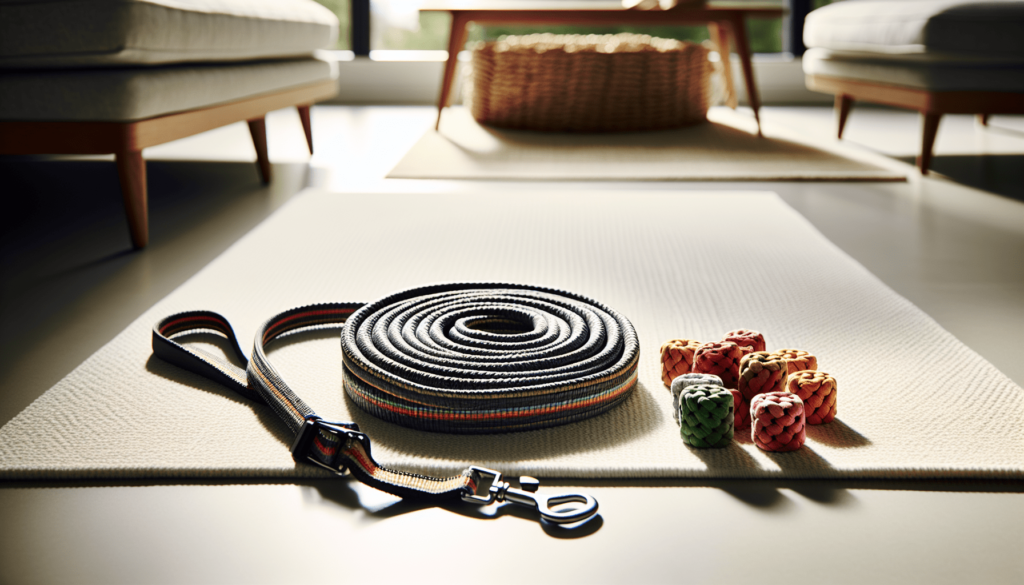Have you ever found yourself being yanked down the sidewalk by your exuberant dog, wishing you had a better way to manage those strong pulls?
For those living in apartments, mastering leash training can feel like a daunting task, especially when space is tight.
But don’t worry; you’re not alone in this challenge, and there are effective techniques to help you and your pooch navigate the streets with ease and comfort.
Understanding the Importance of Leash Training
When living in an apartment, leash training takes on added significance.
It’s not just about ensuring your dog behaves; it’s about the safety and comfort of both you and your furry friend.
Why is Leash Training Crucial for Apartment Dwellers?
Leash training is essential because it ensures that your dog is under control during walks, which is particularly important when navigating tight spaces and busy urban environments.
It also helps establish a strong bond between you and your dog as you work together to master this skill.
- Safety Risks: Pulling can lead to potential accidents, either for your dog or for people around you.
- Peaceful Walks: A well-trained dog leads to less stress and more enjoyable outings, which is particularly important in a bustling area.
- Socialization: Proper leash manners can enhance your dog’s ability to interact with people and other pets peacefully.
What Challenges Do Apartment Dwellers Face?
In an apartment setting, various factors play into the leash training process:
- Limited Space: Unlike homes with yards, apartments require more focus on leash control during walks since there’s less room for spontaneous play.
- Neighbors: Barks and pulls can disturb neighbors, making a well-trained dog essential for communal living.
- Distractions: Urban environments come with numerous distractions that can make training more difficult.
Common Reasons Dogs Pull on Leashes
Understanding why dogs pull on leashes can help you address the underlying issues more effectively.
Why Does My Dog Pull?
- Excitement: Some dogs get overwhelmed with excitement at the prospect of a walk, leading them to pull ahead.
- Territorial Behavior: Dogs may pull towards other dogs or even people, reacting to their presence in a way that asserts dominance or curiosity.
- Lack of Training: For many dogs, pulling is simply a lack of understanding the appropriate walking etiquette.
How Can You Identify the Cause?
Understanding the root cause can make all the difference.
- Observe Reactions: Take note of when your dog pulls. Is it in response to another dog, a person, or just the excitement of being outside?
- Timing and Triggers: Keep track of patterns during walks to help identify specific triggers.
- Behavioral Test: Use treats or a toy to see if you can get their focus back on you during pulls, checking if they can be redirected.

Essential Tools for Leash Training
Before diving into the techniques, it’s crucial to have the right equipment.
What Leash and Collar Should You Choose?
- Harness vs. Collar: A front clipping harness can reduce pulling effectively by redirecting your dog’s attention.
- Training Leash: Consider a shorter training leash that provides more control during training sessions.
- Clicker or Treats: Having a clicker and some treats helps reinforce positive behavior.
How Do You Use Your Gear Effectively?
- Comfort Fit: Make sure the harness is correctly fitted to prevent discomfort or chafing.
- Familiarity: Allow your dog to get acquainted with the harness before starting your training sessions.
- Consistency: Use the same leash and harness consistently to avoid confusion.
Techniques to Instantly Stop Pulling
There are numerous tried-and-true techniques you can adopt to stop your dog from pulling while leasing training.
Can You Use the ‘Stop and Go’ Method?
This method involves stopping every time your dog starts to pull:
- Commit to Stopping: Every time your dog pulls, stop in your tracks and remain still.
- Wait for Attention: Only resume walking once your pup is calm and focused on you.
- Praise and Reward: Use treats or praise when they remain by your side; this reinforces the desired behavior.
How About the ‘Turn Around’ Technique?
The ‘Turn Around’ technique is effective for redirecting your dog’s energy:
- Change Direction: When your dog pulls, turn around and walk in the opposite direction.
- Encourage Following: Make it exciting for your dog to follow you by encouraging them with treats.
- Praise: Offer plenty of praise when your pup catches up, rewarding their focus on you.
Is the ‘Loose-Leash Walking’ Important?
Loose-leash walking is about teaching your dog to maintain tension-free engagement with you:
- Establish a Reward System: Your dog should learn that walking beside you earns praises and treats.
- Practice ‘Heel’ Command: Train your dog to walk at your side using the heel command, rewarding them for staying in position.
- Regular Practice: Make this a regular part of your routine to establish lifelong habits.
Interaction and Engagement
Building engagement is vital to improving your leash training efforts.
How Can You Make Walks More Fun?
- Sniffing Breaks: Allow your dog designated times to sniff and explore; it can be distracting but also rewarding!
- Interactive Games: Introduce games like fetch during park visits to keep the training enjoyable.
- Incorporate Training: Use walks as an opportunity to practice commands and tricks to keep your dog engaged.
Should You Include Distractions in Training?
Introducing distractions is an integral part of leash training.
- Gradual Exposure: Start with low-distraction environments and progressively increase the level of distractions as your dog gets comfortable.
- Controlled Environment: Utilize training classes where distractions are normal and manageable.
- Friendly Faces: Occasionally have friends bring their pets to practice control and engagement.
Maintaining Consistency and Patience
No successful training session is complete without a strong dose of consistency and patience.
How Important Are Regular Training Sessions?
- Consistency is Key: Regular training leads to quicker success; short, frequent sessions are often better than longer ones.
- Daily Routine: Incorporate leash training into your daily routine so it becomes second nature to your dog.
- Monitor Progress: Keep a journal of your puppy’s progress and setbacks to evaluate what works best.
How Can You Stay Patient?
- Realistic Expectations: Remember that training takes time and that every dog is different.
- Celebrate Small Wins: Reward yourself as much as you reward your dog! Each step forward is a victory.
- Seek Support: If you find yourself struggling, consider involving a professional trainer for guidance.
When to Seek Professional Help
Sometimes, despite your best efforts, progress may stall.
Are There Signs That Indicate You Need a Trainer?
- Recurrent Issues: If you’re facing ongoing issues regardless of your training attempts, a professional can offer insights.
- Behavioral Problems: Aggression or anxiety issues while on a leash may benefit from a more specialized approach.
- Training Fatigue: If you feel overwhelmed, seeking professional support can rekindle your enthusiasm for training.
What to Look for in a Trainer?
- Experience and Credentials: Search for trainers who are certified and have a good reputation.
- Training Philosophy: Make sure their training methods align with your values and goals.
- Trial Sessions: Many trainers offer trial sessions, which can be beneficial in determining if they’re a good fit.
Frequently Asked Questions
FAQ 1: Can leash training be done indoors?
Absolutely! Begin practicing in your apartment or a nearby hallway before heading outside.
FAQ 2: How long does leash training take?
It varies by dog, but consistency over weeks is often necessary.
FAQ 3: What should I do if my dog still pulls?
Revisit the techniques, introduce more distractions, and stay patient.
FAQ 4: Is it too late to train an older dog?
No! Dogs of all ages can learn new behaviors with practice.
FAQ 5: What treats work best for reinforcement?
Find soft, small treats your dog loves as they work best for quick rewards.
FAQ 6: How often should I practice leash training?
Aim for a few times a week in varied environments to reinforce the behavior.
FAQ 7: Can I use a retractable leash?
While they can be beneficial in certain contexts, they are generally not recommended for training purposes due to reduced control.
FAQ 8: How should I handle distractions on walks?
Practice “click and treat” systems to redirect their focus back to you amidst distractions.
FAQ 9: What if my dog is fearful of other dogs?
Consider seeking a trainer to help with the fear-based behaviors.
FAQ 10: How do I make leash training part of our routine?
Incorporate it into daily activities, such as walks to the park or trips to the vet, revisiting your training commands often.
In conclusion, leash training is a vital investment in your relationship with your dog, particularly for apartment dwellers.
By implementing these techniques and maintaining patience and consistency, you will see progress over time.
Remember that every dog is unique, so focus on finding what works best for you and your furry companion.
Are you ready to transform your walks into calm and enjoyable journeys? Start putting these tips into action!
